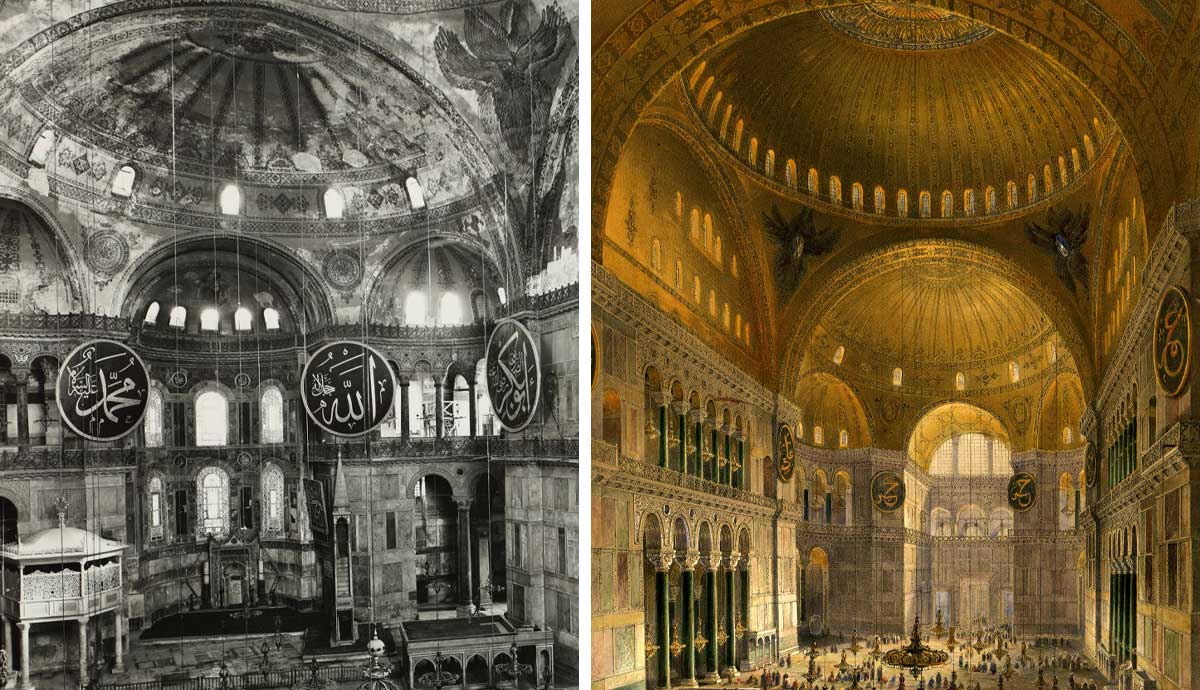Hagia Sophia: 1600 Years Of History And Engineering

Table of Contents
The Construction and Architectural Marvels of the Hagia Sophia (532-537 AD)
The Genius of Anthemius of Tralles and Isidore of Miletus:
The Hagia Sophia's construction, completed in a remarkably short time (around 5 years), was overseen by two brilliant architects: Anthemius of Tralles and Isidore of Miletus. Their innovative design pushed the boundaries of architectural engineering for its time. A crucial innovation was the use of pendentives, curved triangular structures that seamlessly transitioned the weight of the massive dome onto the four supporting piers. This ingenious solution allowed for a vast, central dome to be built without the need for massive, intrusive supporting columns in the main space.
- Materials: The construction utilized a variety of materials, including brick, marble from various regions (giving a stunning visual effect), and other high-quality building components sourced from across the Byzantine Empire. This selection reflects the immense resources and imperial power behind the project.
- Dome Construction: The sheer scale of the dome (originally around 107 feet in diameter) posed a significant engineering challenge. The architects employed complex techniques to build and support this immense structure, utilizing lightweight materials and sophisticated structural systems.
A Symbol of Byzantine Power and Faith:
The Hagia Sophia wasn't merely a building; it was a powerful symbol of the Eastern Roman Empire's might and the unwavering faith of its citizens. Its immense size and grandeur served as a visual testament to imperial power and religious devotion. The Hagia Sophia's central position in Constantinople solidified its importance as the religious heart of the Byzantine world.
- Imperial Power: The sheer scale of the building, its lavish decoration, and its central location reflected the power and wealth of the Byzantine Empire. The Hagia Sophia stood as a beacon of imperial authority.
- Religious Significance: The Hagia Sophia played host to countless religious ceremonies and celebrations, shaping Byzantine art and religious practices for centuries. Its breathtaking mosaics and other interior decorations depicted biblical scenes and imperial figures, reflecting the intertwining of religious and political power within the Byzantine Empire.
- Byzantine Art and Culture: The Hagia Sophia's interior, richly adorned with mosaics and other artistic elements, significantly influenced Byzantine art and culture, leaving an enduring legacy on the artistic sensibilities of the empire and beyond. Many of these works continue to awe visitors.
Transformations and Adaptations Throughout History
From Cathedral to Mosque (1453-1931):
The Ottoman conquest of Constantinople in 1453 marked a pivotal moment in the Hagia Sophia's history. The building was converted into a mosque, a testament to the shifting religious and political landscape of the region. Sultan Mehmed II, after conquering Constantinople, ordered the preservation of the structure, initiating its transformation into a place of Islamic worship.
- Ottoman Additions: The Ottomans added several Islamic architectural elements, including minarets (tall, slender towers from which the call to prayer is made) and a mihrab (a niche in the wall indicating the qibla, the direction of Mecca). These additions did not detract from the original grandeur of the building but instead added another layer of rich history.
- Impact of Conversion: This conversion significantly altered the interior use of the building and its atmosphere, while respecting its existing structural integrity. The existing mosaics were mostly covered, and new elements reflected Islamic religious practice. The transition reflects the long and complex interweaving of cultures and religious practices at the heart of Istanbul.
- Prominent Figures: Many significant figures in Ottoman history were associated with the Hagia Sophia during its mosque period, using it as a place of worship and governance.
Secularization and the Hagia Sophia Museum (1935-Present):
In 1935, under the Republic of Turkey, the Hagia Sophia was transformed into a museum, a significant step towards secularization. This decision aimed to preserve the building's rich history and cultural significance for all people, regardless of religious affiliation.
- Preservation Efforts: The conversion to a museum involved the careful removal of some Islamic additions and the systematic preservation of the existing historical elements, including the gradual uncovering of the original Byzantine mosaics.
- Global Significance: The Hagia Sophia Museum serves as an important site for cultural preservation, attracting visitors and scholars from around the world, showcasing the intertwined history of Byzantium and the Ottoman Empire.
- Ongoing Debates: Despite its current status, discussions and debates regarding the Hagia Sophia's official designation continue, highlighting the building’s deep historical and cultural significance and its ongoing role in contemporary political and social discourse.
The Engineering Brilliance of the Hagia Sophia
Innovative Structural Design:
The Hagia Sophia's enduring structural integrity is a testament to the remarkable engineering skills of its Byzantine builders. The innovative structural design incorporates several key elements:
- Dome Support: The dome's construction remains a marvel of engineering. The pendentives cleverly distribute the immense weight, preventing the need for internal supports and creating a vast, open interior space.
- Arches and Vaults: A complex system of arches and vaults complements the pendentives, further distributing the load and ensuring stability. These were constructed using precisely cut and placed brick and stone.
- Earthquake Resilience: The Hagia Sophia has remarkably survived numerous earthquakes, a testament to the robustness of its design and construction. The flexible nature of some of the materials and the overall design contributed to its ability to withstand seismic activity.
Materials and Construction Techniques:
The quality of materials and the meticulous craftsmanship involved in the Hagia Sophia's construction were exceptional for their time.
- Material Sourcing: The architects and builders sourced high-quality materials from across the Byzantine Empire, emphasizing durability and aesthetic appeal.
- Byzantine Craftsmanship: The skills and techniques of the Byzantine builders and artisans were extraordinary, reflecting a mastery of their craft passed down through generations. Their precision and attention to detail are still evident today.
- Comparison to Other Structures: Comparing the Hagia Sophia's construction techniques with other contemporary and later structures reveals its innovation and superiority in structural engineering and design.
Conclusion:
The Hagia Sophia, a timeless symbol of architectural genius, stands as a testament to the ingenuity and artistry of its creators. From its awe-inspiring dome to its captivating history spanning sixteen centuries, the Hagia Sophia's legacy continues to inspire wonder. Through its evolution from a magnificent cathedral to a revered mosque and now a museum, this architectural masterpiece offers a unique insight into the rich tapestry of human history and the enduring power of exceptional engineering. To truly appreciate the brilliance of this iconic structure, a visit to the Hagia Sophia is essential. Learn more about the architectural marvel that is the Hagia Sophia and plan your visit today!

Featured Posts
-
 Canadas Election 2023 Is Mark Carney Losing Ground
Apr 29, 2025
Canadas Election 2023 Is Mark Carney Losing Ground
Apr 29, 2025 -
 Bof As Take Why High Stock Market Valuations Shouldnt Worry Investors
Apr 29, 2025
Bof As Take Why High Stock Market Valuations Shouldnt Worry Investors
Apr 29, 2025 -
 Free Streaming Options For Untucked Ru Pauls Drag Race Season 17 Episode 8
Apr 29, 2025
Free Streaming Options For Untucked Ru Pauls Drag Race Season 17 Episode 8
Apr 29, 2025 -
 Nba Disciplines Anthony Edwards With 50 000 Fine
Apr 29, 2025
Nba Disciplines Anthony Edwards With 50 000 Fine
Apr 29, 2025 -
 Rethinking Adhd Diagnosis In The Age Of Tik Tok
Apr 29, 2025
Rethinking Adhd Diagnosis In The Age Of Tik Tok
Apr 29, 2025
